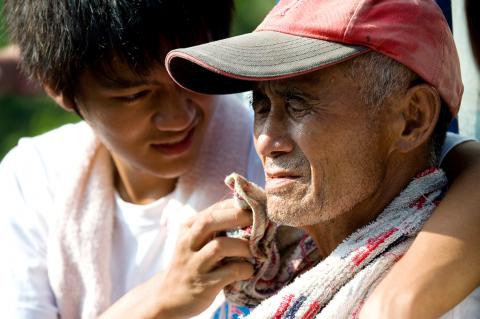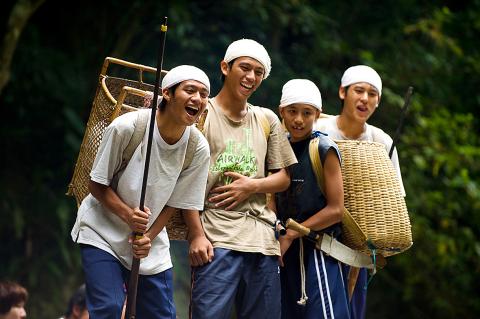For her debut feature Finding Sayun (不一樣的月光), Atayal director Chen Chieh-yao (陳潔瑤) returns to her home village to unearth the legend of Sayun (sometimes spelled Sayion), an Atayal girl who fell to her death in a turbulent stream while carrying a Japanese teacher’s belongings at the end of World War II.
Whereas Wei Te-sheng’s (魏德聖) big-budgeted Seediq Bale (賽德克.巴萊) tackled Aboriginal history in the form of battle epic, Chen (or Laha Mebow in Atayal) takes a completely different approach, examining her Aboriginal roots through personal memories and scenes from everyday life.
The movie begins when the tale of Sayun draws a television crew to the Atayal hamlet of Tyohemg (金岳) in Nanao Township (南澳), Yilan County. Yukan (Tsao Shih-hui, 曹世輝), a high-school boy and a young hunter, does not understand the crew members’ interest in the story. But his grandfather’s (Chang Chin-chen, 張金振) memories of Sayun, whom he went to school with, revives his interest in the old tribal village, which the villagers had been forced to desert 50 years prior.

Photo courtesy of Sky Films Entertainment
The grandfather wants to pay a visit to his childhood home, and Yukan is determined to fulfill the old man’s wish. One day at dawn, together with Yukan’s friend A-guo (Cheng Chia-yeh, 鄭嘉業) and Hsiao-ju (Fang Chih-yu, 方志友) from the crew, they embark on a journey along the treacherous trail to the Atayal home.
Shot entirely in and around the Atayal village and with a cast of mostly nonprofessional, Aboriginal actors, the film is director Chen’s sincere attempt to reconnect with her roots. She delivers a refreshing, lively portrait of Aborigines, who are often depicted as miserable and depressed in films such as Everlasting Moments (靈魂的旅程). Lin Ching-tai (林慶台), who plays Mouna Rudo in Seediq Bale, returns in this movie to his real-life profession (he’s a pastor) and the young Atayal actors give confident performances.
To be honest, Finding Sayun is a debut effort with many flaws. Its storytelling is uneven, and the decision to insert two irrelevant Chinese characters — in order to woo Chinese investors perhaps? — is awkward. Moreover, the film can be fairly confusing to audience members unfamiliar with the legend of Sayun.

Photo courtesy of Sky Films Entertainment
The significance of the story surfaces only if one knows how Japanese colonialists used it for propaganda purposes, the fact that director Chen’s grandmother was Sayun’s classmate and friend, and how the late banker Lin Keh-hsiao (林克孝) kindled public interest in the village when he wrote a book in 2009 about his years investigating the story of Sayun.
Still, Chen knows that there is more than one way to look at history, and uses documentary footage to show how differently the story is remembered by the villagers she interviews. In the end, Finding Sayun is the director’s journey of finding her own way home as she follows the 77-year-old tribal elder Chang to the place where her grandparents were born and the ancestral spirits still dwell.

Photo courtesy of Sky Films Entertainment

This month the government ordered a one-year block of Xiaohongshu (小紅書) or Rednote, a Chinese social media platform with more than 3 million users in Taiwan. The government pointed to widespread fraud activity on the platform, along with cybersecurity failures. Officials said that they had reached out to the company and asked it to change. However, they received no response. The pro-China parties, the Chinese Nationalist Party (KMT) and Taiwan People’s Party (TPP), immediately swung into action, denouncing the ban as an attack on free speech. This “free speech” claim was then echoed by the People’s Republic of China (PRC),

Exceptions to the rule are sometimes revealing. For a brief few years, there was an emerging ideological split between the Democratic Progressive Party (DPP) and Chinese Nationalist Party (KMT) that appeared to be pushing the DPP in a direction that would be considered more liberal, and the KMT more conservative. In the previous column, “The KMT-DPP’s bureaucrat-led developmental state” (Dec. 11, page 12), we examined how Taiwan’s democratic system developed, and how both the two main parties largely accepted a similar consensus on how Taiwan should be run domestically and did not split along the left-right lines more familiar in

As I finally slid into the warm embrace of the hot, clifftop pool, it was a serene moment of reflection. The sound of the river reflected off the cave walls, the white of our camping lights reflected off the dark, shimmering surface of the water, and I reflected on how fortunate I was to be here. After all, the beautiful walk through narrow canyons that had brought us here had been inaccessible for five years — and will be again soon. The day had started at the Huisun Forest Area (惠蓀林場), at the end of Nantou County Route 80, north and east

Specialty sandwiches loaded with the contents of an entire charcuterie board, overflowing with sauces, creams and all manner of creative add-ons, is perhaps one of the biggest global food trends of this year. From London to New York, lines form down the block for mortadella, burrata, pistachio and more stuffed between slices of fresh sourdough, rye or focaccia. To try the trend in Taipei, Munchies Mafia is for sure the spot — could this be the best sandwich in town? Carlos from Spain and Sergio from Mexico opened this spot just seven months ago. The two met working in the